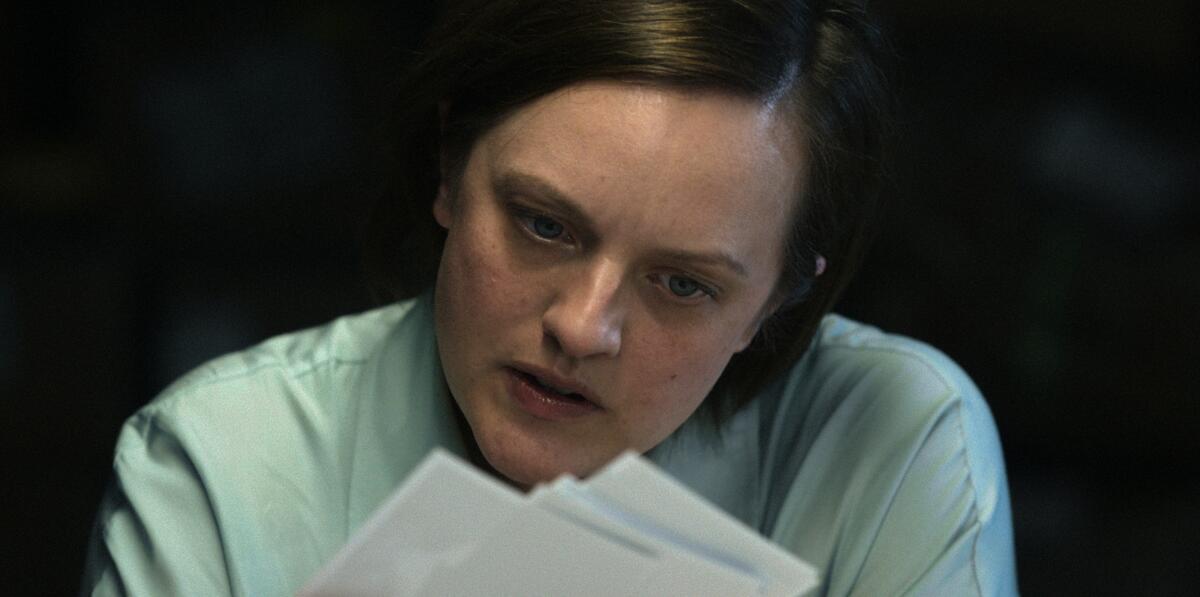Apple’s ‘Shining Girls’ wouldn’t be half as good without the great Elisabeth Moss

- Share via
In “Shining Girls,” premiering Friday on Apple TV+, Elisabeth Moss plays Kirby Mizrachi, a Chicago newspaper archivist who, having survived a brutal attack six years earlier — we are in 1992 — is brought out of her cocoon when the body of another woman is discovered with similar wounds. It brings her into a rocky partnership with Dan Velasquez (Wagner Moura), a reporter working his way back from an alcohol-tinged personal low point — “Dan doesn’t break stories, he chases them,” someone will say of him — as they set out together to crack the case, going where the police don’t care to go.
Without putting too fine a point on it, lest one be accused of revealing a plot mechanism that in any case becomes implicitly obvious early on, viewers who have seen both series will be excused for thinking back a week and a half to “Russian Doll,” with which “Shining Girls” shares an interest in time travel, cosmic remodeling and quantum physics, as well as a compact heroine getting a handle on her life.
“He’s everybody, he’s nobody, he’s all the time,” Kirby says of her assailant, whose face she never saw.
The complete guide to home viewing
Get Screen Gab for everything about the TV shows and streaming movies everyone’s talking about.
You may occasionally receive promotional content from the Los Angeles Times.
Without putting too fine a different point on it, it is a serial killer story — one with a twist, most assuredly, but even the most twisted serial killer is basically a creep whose motivations, whether springing from human trauma or supernatural influence and embarked on as a sociopathic art project, are all too familiar. There are only so many arrows in that quiver, however you decorate them, and however much sympathy for the devil might be created on the page or in the performance. (I recognize that people love these stories, going back at least to Jack the Ripper, and I can only say I’m sorry that this is so.) They are “scary,” since the killer is required by law of the genre to try to kill again, but they are also, given a limited range of narrative moves, predictable.
So it’s all to the good that showrunner Silka Luisa, working from Lauren Beukes’ 2013 novel, takes an original turn with her protagonist. Kirby’s reality is fractured: Things in one place are in another, or they are different things. Is this desk not her desk? Does she live with her mother, Rachel (Amy Brenneman), a Patti Smith manqué, or with Marcus (Chris Chalk), a colleague? Is her dog a cat, or is her cat a dog? Is her name even Kirby? “Everything is like always, and then it’s not,” she tells Rachel, who, like most of those to whom she describes this strangeness, will assume the problem is with Kirby, and not with the world, which changes around her, including scenes that do not include her at all. Like Nadia in “Russian Doll,” she is a more or less reliable narrator in an unreliable world.
As to our killer, Harper Curtis, played by Jamie Bell — that is not a spoiler; you will have understood that within a few minutes — he is just a dude without qualities, presentable if not exactly charming, who shows up here and there, lurking or attacking. Although the series will get around to giving him a bit of a backstory and context, including an interesting but underused pal (Christopher Dunham as Leo) with some brief psychoanalysis from other characters, he is fundamentally an abstraction, the execution of an idea that lets everything else happen. Similarly, when we meet Jin-Sook (Phillipa Soo), an astronomer working at the local planetarium, we do not need to see the wingless bee on her desk, calling back to the series’ opening scene, to know that Curtis and the screenwriters have marked her as a target — it’s her job.
It’s taking nothing away from the rest of a fine cast to note that “Shining Girls” is 75% the Elisabeth Moss Show, and not merely because the world turns literally around Kirby. An actress of great intelligence and emotional nuance, immune to convention, Moss excels at characters with a note, or a block chord, of complication. Turning 40 this year, which is to say evidently older than Kirby, she creates a chronologically amorphous person whom fate has locked in time. (She plays her even younger as well, in what might be called a flashback in a more linear tale.) Moss softens Kirby’s edges, pulls the body out of her voice, and tucks her head into her shoulders; she gives her a hunted animal look. This will change, as she comes out of hiding and goes, incrementally, on the offensive. Her choices are never pat; the series wouldn’t be half as good without her.
The star of Netflix’s dark comedy steps into the showrunner role in Season 2 — and rethinks how place, time and family history can help tell a person’s story.
That said, there are other things to recommend it, in the production and the performances, a sense of the ordinary that keeps the uncanny elements rooted to something recognizably real, and makes characters that flirt with cliche into people you can believe in. The series is an unusual mix of fantasy and horror with a newspaper procedural — yes, I do remember “Kolchak, the Night Stalker” — and though it strikes me as a little shaky on the procedure, the re-creation of a 1992 newsroom is absolutely spot on. Chicago locations, both scenic and humble, give the series a firm sense of place and make it nice to look at.
That the showrunner and the directors (including Moss) are women may have something to do with the series avoiding the more egregious faults of the genre; violence for the most part happens offscreen, or quickly; gore is restricted to crime scene photos. The violence is not sexual — there is nothing in the way of sex at all, for that matter — though it is gendered: A man is killing women. Because. The series is not without elements of tenderness, though, nicely portrayed and a necessary relief. If what are meant to be the eerie parts of the story do not deliver much of a frisson, the more human interactions do create a nice glow.
In the end, the business of these stories generally comes down to the same questions: sorting out how long we have to wait before the killer gets his (it’s almost always a “he”) comeuppance, if he does, and how many other victims might be thrown at us in the meantime; the mechanics of the killing; what twists, from the old bag of twists, eerie and otherwise, might be applied at the end; and whether the end will be or, as it too often is not in horror stories, an ending.
‘Shining Girls’
Where: Apple TV+
When: Any time, starting Friday
Rating: TV-MA (may be unsuitable for children under the age of 17)
More to Read
The complete guide to home viewing
Get Screen Gab for everything about the TV shows and streaming movies everyone’s talking about.
You may occasionally receive promotional content from the Los Angeles Times.








